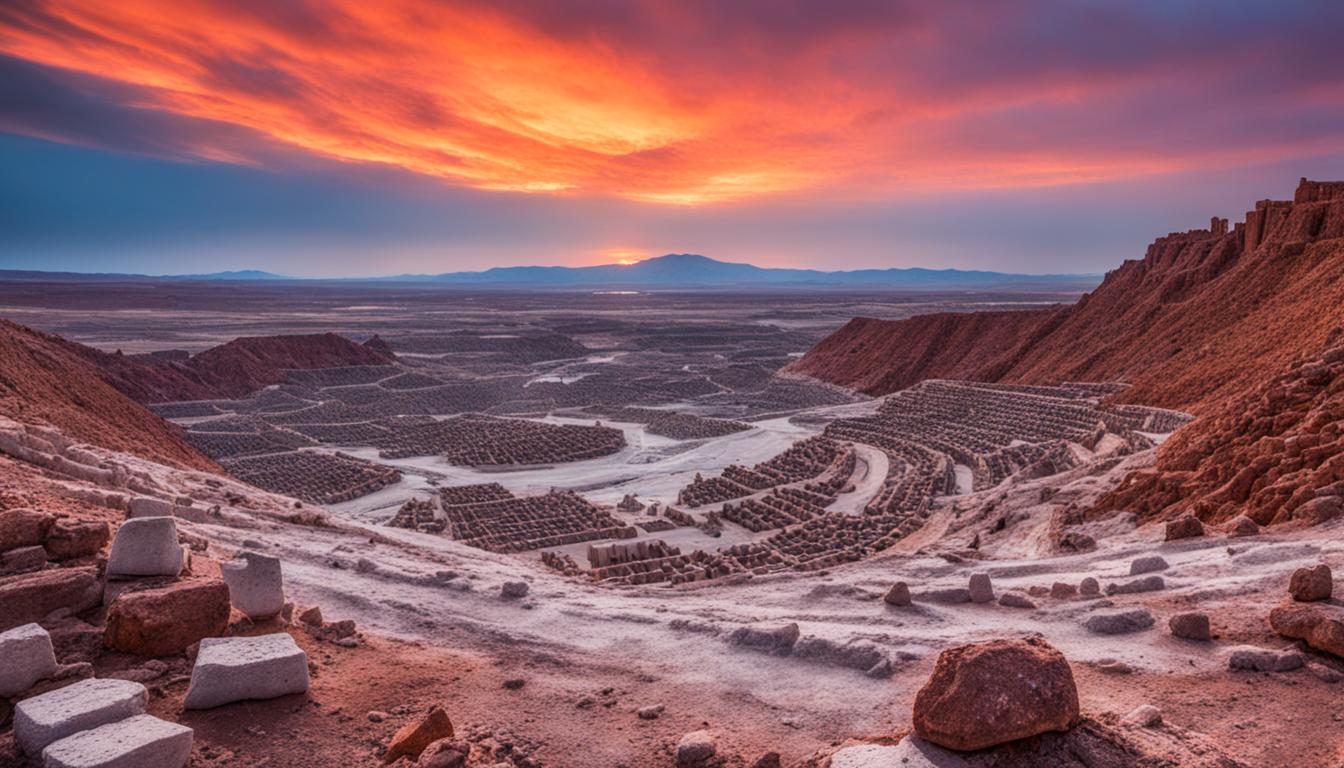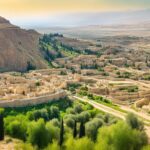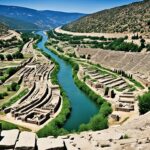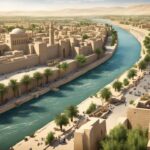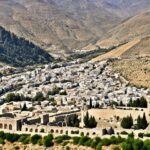When exploring the rich tapestry of biblical cities, one cannot overlook the infamous cities of Sodom and Gomorrah. These ancient cities are not only historical landmarks but also hold immense significance in the Old Testament. The mention of Sodom and Gomorrah in the Bible conjures images of divine retribution, destruction, and the consequences of human wickedness.
What makes these cities even more intriguing is that they have been found in the real world, providing tangible evidence that supports the biblical narrative. Today, we will delve into the fascinating story of Sodom and Gomorrah, exploring their locations, archaeological discoveries, and the lessons we can learn from these ancient sin cities.
Key Takeaways:
- The cities of Sodom and Gomorrah have been found, validating the accuracy of the Bible’s account of their existence.
- The narrative of Sodom and Gomorrah serves as a cautionary tale about wickedness and divine judgment.
- Archaeological discoveries at sites such as Bab edh-Dhra and Numeira provide further evidence supporting the biblical account.
- Sodom and Gomorrah symbolize the consequences of rebellion against God and the importance of righteousness and obedience.
- The story of Lot’s wife serves as a reminder of the consequences of disobedience.
The Significance of Gomorrah in the Bible
The cities of Sodom and Gomorrah hold great significance in the Old Testament stories and biblical references. These cities are known as symbols of wickedness and divine retribution. According to the biblical narrative, they were destroyed by fire and brimstone due to their sinful behavior (First source).
This destruction serves as a powerful reminder of the consequences that await those who deviate from righteousness. The story of Sodom and Gomorrah provides a clear example of the judgment that can befall individuals and communities that choose to indulge in immoral practices.
“And the Lord said, ‘Because the outcry against Sodom and Gomorrah is great and their sin is very grave, I will go down to see whether they have done altogether according to the outcry that has come to me. And if not, I will know.’” (Genesis 18:20-21)
The destruction of Sodom and Gomorrah carries theological significance as well. It serves as a warning and an admonition for people to adhere to God’s commands and live righteous lives.
To visualize the scale of this event, an image depicting the destruction of Sodom and Gomorrah is provided below:
Locating Sodom and Gomorrah
The geographical location of the cities mentioned in the biblical account of Sodom and Gomorrah points to their existence in the vicinity of the Dead Sea, specifically in the plain south of the sea. To support this biblical account, archaeological surveys have been conducted in the southeastern region of the Dead Sea, resulting in the identification of potential sites related to the Cities of the Plain.
Two notable sites that have been unearthed in this area include Bab edh-Dhra and Numeira. These sites offer valuable insights into the ancient history and possible locations of Sodom and Gomorrah, shedding light on the accuracy of the biblical narrative.
| Archaeological Site | Location | Key Findings |
|---|---|---|
| Bab edh-Dhra | East side of the Lisan peninsula | Unearthed evidence of an Early Bronze Age town that aligns with the biblical description of Sodom |
| Numeira | 13 km south of Bab edh-Dhra | Displays similarities to the biblical account of the destruction of the Cities of the Plain |
These discoveries offer intriguing possibilities regarding the location of Sodom and Gomorrah, providing a tangible link between the archaeological findings and the biblical account.

Discoveries at Bab edh-Dhra and Numeira
Excavations at Bab edh-Dhra, located on the east side of the Lisan peninsula, have revealed fascinating archaeological discoveries that shed light on the biblical city of Sodom. This Early Bronze Age town exhibits striking similarities to the biblical description of Sodom, providing tangible evidence of its existence.
The extensive excavations at Bab edh-Dhra have unearthed a well-preserved urban center dating back thousands of years. The layout, structures, and artifacts found at the site align closely with the biblical account, reinforcing the significance of this ancient city.
Not far from Bab edh-Dhra, approximately 13 kilometers to the south, lies the site of Numeira. This archaeological site also offers intriguing parallels to the biblical narrative of the destruction of the Cities of the Plain.
The discoveries at Numeira provide additional corroborating evidence of the biblical cities destroyed. The remnants of this ancient settlement, including pottery, relics, and architectural remnants, offer insights into the daily life and cultural practices of the inhabitants of the Cities of the Plain.
Identifying the Sites of Sodom and Gomorrah
Based on biblical clues and geographical analysis, the likely location of Sodom has been identified as Bab edh-Dhra. This site, situated in the vicinity of the Dead Sea, aligns with the biblical descriptions of the city and its destruction. Additionally, the discovery of a massive Bronze Age city at Tall el-Hammam provides further evidence supporting the biblical account of the destruction of Sodom and Gomorrah, making it one of the most significant archaeological finds of the 21st century (Third source).
Geographical Location: The cities of Sodom and Gomorrah, as mentioned in the Bible, are believed to have been situated in the plain south of the Dead Sea.
Archaeological Find of the 21st Century: The excavation of Bab edh-Dhra and the discovery of a Bronze Age city at Tall el-Hammam have shed light on the historical accuracy of the biblical account, making this archaeological find significant in the 21st century and offering valuable insights into the ancient cities and their demise.

| Site | Description |
|---|---|
| Bab edh-Dhra | An archaeological site southeast of the Dead Sea that aligns with the biblical description of Sodom. Excavations have uncovered evidence of an Early Bronze Age town, including fortified walls and a massive gate. |
| Tall el-Hammam | Located nearby, this site reveals the remains of a Bronze Age city, thought to be the biblical city of Sodom. The city was highly advanced and contained monumental structures, indicating its significance during that time. |
Historical Significance of Sodom and Gomorrah
The destruction of Sodom and Gomorrah carries immense historical significance, as it serves as a powerful reminder of the consequences that accompany wickedness and rebellion against God. The archaeological discoveries made in relation to these biblical cities further enhance our understanding of the theological themes present in the narrative, emphasizing the importance of righteousness and obedience.
“Then the Lord rained on Sodom and Gomorrah sulfur and fire from the Lord out of heaven. And he overthrew those cities, and all the valley, and all the inhabitants of the cities, and what grew on the ground.” – Genesis 19:24-25
The tale of Sodom and Gomorrah serves as a cautionary tale, demonstrating the destructive consequences of indulging in wicked practices. It reflects the core theological teachings of the biblical narrative, urging individuals to lead lives of righteousness and obedience to God’s commands.
Theological Themes
The biblical account of the destruction of Sodom and Gomorrah is intertwined with several theological themes that hold enduring relevance. One of the key themes is the concept of divine judgment, wherein God punishes rampant evil and rebellion with devastating consequences. This serves as a reminder that no one is above accountability and that actions have repercussions.
Additionally, the narrative highlights the importance of righteousness and obedience. It underscores the significance of aligning one’s life with God’s principles, thereby avoiding the path of wickedness that can lead to destruction. The tale of Sodom and Gomorrah reaffirms the notion that righteousness is rewarded, while disobedience carries severe consequences.
Archaeological Discoveries
Archaeological excavations have provided valuable insights into the historical context of Sodom and Gomorrah. These discoveries validate the existence of these ancient cities, offering tangible evidence of their importance during their time. The archaeological findings act as corroborative evidence, supporting the accuracy of the biblical account and reinforcing its historical significance.
Image:

Cultural and Religious Practices of Sodom and Gomorrah
The biblical account of Sodom and Gomorrah reveals that these cities were renowned for their widespread immorality and idolatrous practices. The inhabitants engaged in sinful behaviors that directly disregarded God’s intended design for human relationships.
According to the second source, the cultural and religious practices in Sodom and Gomorrah were characterized by deep-rooted corruption. The people of these cities indulged in various immoral activities, including but not limited to promiscuity, homosexuality, and sexual exploitation.
“Their menfolk were all astir; young and old thronged the streets and squares. They called to Lot and asked where the men who had come to his house were. ‘Bring them out to us,’ they pleaded, ‘so that we can have sex with them.’” – Second source
These practices clearly contradict the biblical narrative and the divine principles laid out in the Old Testament. They epitomize the rampant defiance of God’s laws and the abandonment of righteousness.
“And the LORD said, ‘Because the outcry against Sodom and Gomorrah is great, and because their sin is very grave, I will go down now and see whether they have done altogether according to the outcry against it that has come to Me; and if not, I will know.’” – First source
The cultural and religious practices of Sodom and Gomorrah serve as a cautionary tale, underscoring the dire consequences of deviating from God’s commandments. These cities’ immoral behavior ultimately led to their destruction as divine judgment.
Just as the biblical narrative highlights the devastating consequences of Sodom and Gomorrah’s cultural and religious practices, it also emphasizes the importance of embracing righteousness and obedience. Through this cautionary tale, individuals are reminded of the need to align their lives with God’s will.

Prophetic and Eschatological Significance
The biblical account of the destruction of Sodom and Gomorrah holds great prophetic and eschatological significance. It serves as a powerful symbol of divine judgment and the severe consequences of rebelling against God’s commands. This catastrophic event, described in the book of Genesis, has been referenced in various prophetic and eschatological texts, reminding humanity of the ultimate judgment that awaits those who choose to reject God’s instructions.
The destruction of Sodom and Gomorrah stands as a prophetic warning, demonstrating the consequences of a society steeped in sin and moral decay. It serves as a sobering reminder that no nation or individual is exempt from divine judgment when they turn away from righteousness.
“Then the Lord rained on Sodom and Gomorrah sulfur and fire from the Lord out of heaven. And he overthrew those cities, and all the valley, and all the inhabitants of the cities, and what grew on the ground.” – Genesis 19:24-25
Throughout history, biblical scholars and theologians have referenced the destruction of Sodom and Gomorrah to highlight the consequences of rebellion against God’s commands and the importance of living a righteous life. This event serves as a reminder that God’s judgment is an inevitable reality, emphasizing the significance of adhering to biblical teachings and moral values.
The proclamations regarding the destruction of Sodom and Gomorrah in prophetic and eschatological texts often emphasize the need for repentance, righteousness, and the acceptance of God’s commands. These teachings urge individuals and societies to turn away from sin and embrace a life of obedience to God, ultimately seeking salvation and avoiding the impending judgment to come.
Lessons from the Prophetic and Eschatological Significance
The prophetic and eschatological significance of the destruction of Sodom and Gomorrah provides valuable lessons for believers today. It underscores the importance of living a life that aligns with God’s will, walking in righteousness, and upholding moral values. Furthermore, it serves as a reminder that God’s judgment is a reality that all must confront, compelling individuals to seek forgiveness, repentance, and a transformed life.
By examining the biblical account of the destruction of Sodom and Gomorrah and understanding its prophetic implications, believers are encouraged to live a life of obedience, turning away from wickedness, and embracing the path of righteousness.
The Story of Lot’s Wife
The biblical narrative includes the story of Lot’s wife, who was turned into a pillar of salt when she looked back at the destruction of Sodom and Gomorrah. This serves as a cautionary tale about the consequences of disobedience.
“But Lot’s wife looked back, and she became a pillar of salt.” – Genesis 19:26
In the biblical account, Lot and his family were instructed to flee from the sinful cities of Sodom and Gomorrah before their destruction. As they were escaping, Lot’s wife disobeyed the command to not look back, resulting in her tragic transformation into a pillar of salt.
This story highlights the significance of obedience and the importance of following divine instructions without hesitations or doubts. It serves as a reminder of the consequences that can arise from disobedience and the need to fully trust and submit to God’s guidance.

Lessons from Lot’s Wife
The story of Lot’s wife offers several important lessons:
- 1. The dangers of dwelling on the past and the inability to let go of sinful influences.
- 2. The significance of complete obedience and trust in God’s commands.
- 3. The consequences of disobedience and the importance of repentance.
- 4. The need for faithfulness and perseverance in following God’s will.
Lot’s wife serves as a reminder that our choices have consequences, urging us to live a life of faith and obedience to God’s commands.
Lessons from Sodom and Gomorrah
The biblical account of Sodom and Gomorrah carries profound lessons that transcend time and cultures. These Old Testament stories provide valuable insights into the importance of righteousness, obedience, and the consequences of sinful behavior. They serve as a powerful reminder of the need to align one’s life with God’s will.
“Then the LORD rained on Sodom and Gomorrah sulfur and fire from the LORD out of heaven. And he overthrew those cities, and all the valley, and all the inhabitants of the cities, and what grew on the ground.” – Genesis 19:24-25
The destruction of Sodom and Gomorrah showcases the severe repercussions of straying from the path of righteousness. This biblical account serves as a cautionary tale, urging individuals to abide by God’s commands and live in accordance with His divine plan. The consequences of indulging in sinful practices are vividly demonstrated through the obliteration of these once-prosperous cities.
Moreover, the biblical narrative surrounding Sodom and Gomorrah emphasizes the significance of obedience. It highlights the dire outcomes that await those who disregard God’s teachings and embrace wickedness. The stories serve as a call to action, encouraging believers to prioritize obedience and fidelity to God’s commandments.
The harrowing tale of Sodom and Gomorrah imparts timeless wisdom, transcending the pages of the Bible. It underscores the eternal principles of righteousness, obedience, and the inevitability of divine justice. The lessons derived from these Old Testament stories continue to resonate in contemporary society, urging individuals to walk in the path of righteousness and make choices that align with God’s will.
The Continuing Debate
Despite the archaeological evidence supporting the existence and destruction of Sodom and Gomorrah, there is an ongoing debate among scholars. Some continue to question the accuracy of the biblical accounts, while others find the archaeological findings compelling.
On one side of the debate, skeptics argue that the biblical narrative of Sodom and Gomorrah should be interpreted allegorically or symbolically, rather than as a historical account. They suggest that the mention of these cities in the Bible is meant to convey moral lessons rather than describe actual events.
“The story of Sodom and Gomorrah serves as a cautionary tale about the consequences of sinful behavior. It highlights the righteous judgment of God and the importance of living a virtuous life.” – Scholar A
On the other side, proponents of the historical accuracy of the biblical account point to the archaeological discoveries that align with the descriptions of Sodom and Gomorrah. These findings, such as the ruins of Bab edh-Dhra and Numeira, provide tangible evidence of the existence of these biblical cities.
Moreover, the destruction of Sodom and Gomorrah is mentioned in various ancient texts, including the New Testament, further supporting its historicity. The consistency between these textual references and the archaeological evidence adds weight to the argument that Sodom and Gomorrah were real cities destroyed in ancient times.
“The discovery of these ancient sites and their similarities to the biblical narrative is compelling evidence that Sodom and Gomorrah were actual cities. It reaffirms the historical accuracy of the Bible.” – Scholar B
The debate surrounding Sodom and Gomorrah continues to spark scholarly discussions and fuel ongoing research. While a consensus has yet to be reached, the exploration of this topic remains essential for understanding the biblical narrative, the historical context, and its significance in shaping religious and cultural beliefs.
Comparative Analysis of Arguments
| Debate | Skeptics | Proponents |
|---|---|---|
| Interpretation of the Biblical Account | Allegorical or symbolic | Historical |
| Evidence | Question the accuracy of the biblical narrative | Aligns with archaeological discoveries |
| Supporting Texts | – | References in various ancient texts |
Conclusion
The tale of Gomorrah in the Bible provides a captivating glimpse into the city’s sinful nature and its ultimate downfall. Supported by archaeological discoveries, the biblical narrative surrounding the cities of Sodom and Gomorrah attests to their historical and cultural significance. These key biblical events serve as a profound reminder of the dire consequences that disobedience can bring.
The archaeological findings bring to life the biblical accounts of the destruction of Sodom and Gomorrah. Through excavations and extensive research, the cities described in the biblical narrative have been identified and linked to tangible evidence. These discoveries shed light on the world in which these events unfolded, reinforcing the authenticity and importance of the biblical narrative.
By recounting the story of Sodom and Gomorrah, the Bible emphasizes the need for righteousness and obedience to God’s commands. The downfall of these cities stands as a cautionary tale, warning against the catastrophic consequences of turning away from divine teachings. It serves as a timeless reminder that righteousness is essential for personal and societal well-being.
FAQ
Where can I find information about Gomorrah in the Bible?
Gomorrah in the Bible is mentioned in the Old Testament, particularly in the story of Sodom and Gomorrah. This biblical account can be found in the book of Genesis, chapters 18 and 19.
Were the cities of Sodom and Gomorrah real?
Yes, there is historical, geographical, and archaeological evidence supporting the existence of the cities of Sodom and Gomorrah mentioned in the Bible.
Where were Sodom and Gomorrah located?
Are there any archaeological discoveries related to Sodom and Gomorrah?
Yes, excavations at sites like Bab edh-Dhra and Numeira, located southeast of the Dead Sea, have revealed evidence that aligns with the descriptions of the biblical cities of Sodom and Gomorrah.
How are Bab edh-Dhra and Numeira connected to Sodom and Gomorrah?
Bab edh-Dhra and Numeira are two archaeological sites in the vicinity of the Dead Sea that have shown similarities to the biblical narratives of the cities of Sodom and Gomorrah. These sites have provided valuable insight into the historical and cultural context of the biblical account.
What can we learn from the story of Sodom and Gomorrah?
The story of Sodom and Gomorrah emphasizes the importance of righteousness and obedience to God’s commands. It serves as a reminder of the consequences of wickedness and rebellion against God.
What were the cultural and religious practices of Sodom and Gomorrah?
According to the biblical narrative, the cities of Sodom and Gomorrah were characterized by sinful behavior, including immorality and idolatry. The inhabitants engaged in practices that went against God’s design for human relationships.
What is the significance of the destruction of Sodom and Gomorrah?
The destruction of Sodom and Gomorrah is often referenced in prophetic and eschatological texts as a symbol of divine judgment and the consequences of rebellion against God. It serves as a reminder of the ultimate judgment that awaits those who reject God’s commands.
Who was Lot’s wife and what happened to her?
Lot’s wife was a character in the biblical narrative of Sodom and Gomorrah. When she looked back at the destruction of the cities, she was turned into a pillar of salt, serving as a cautionary tale about the consequences of disobedience.
What lessons can we learn from the account of Sodom and Gomorrah?
The account of Sodom and Gomorrah teaches us about the importance of righteousness, obedience, and the consequences of sinful behavior. It serves as a reminder of the need to align our lives with God’s will.
Is there any debate regarding the accuracy of the biblical accounts of Sodom and Gomorrah?
Yes, scholars have ongoing discussions and debates about the accuracy of the biblical accounts of Sodom and Gomorrah. However, the archaeological findings and geographical analysis provide compelling evidence supporting the existence and destruction of these cities.
What is the significance of Gomorrah in the Bible?
Gomorrah in the Bible holds significant cultural and historical significance as one of the cities destroyed by God’s judgment. Its story serves as a reminder of the consequences of wickedness and rebellion against God’s commands.
